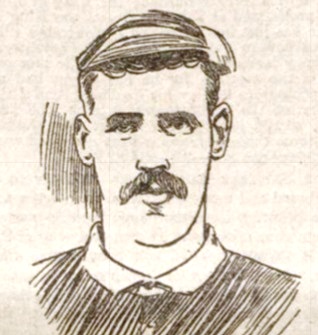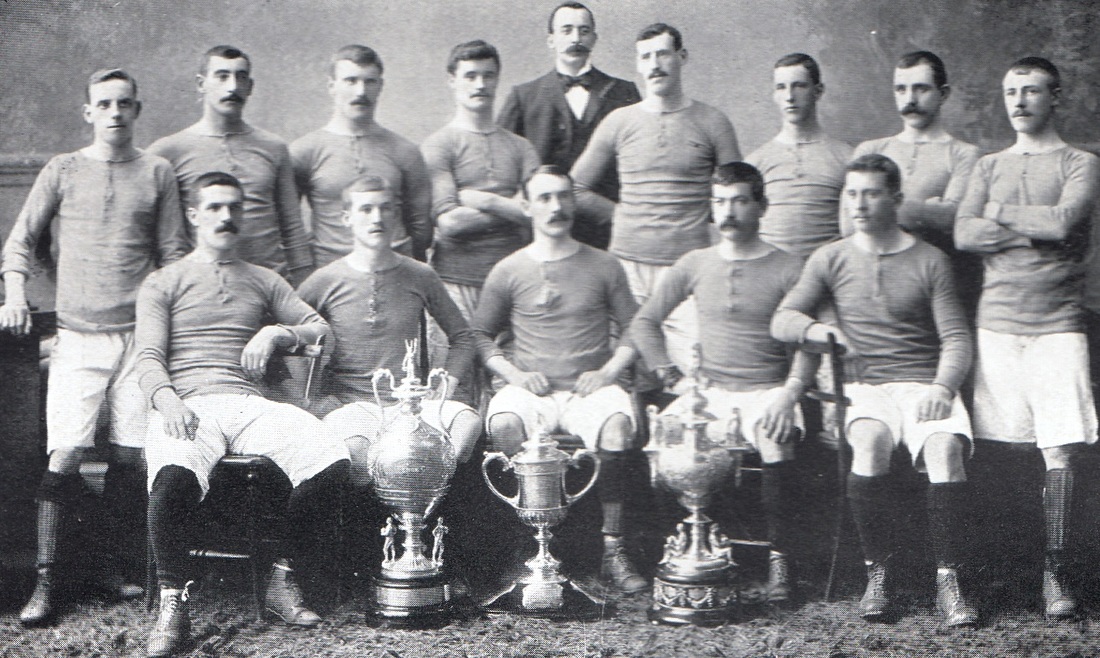It was a crucial clue to the true identity of a man who was twice capped for Scotland against England, won two Scottish Cups, and was famed for his cannonball shot.
Born in Auchinleck as Bryce Scouller, and brought up in Renfrewshire under that name, for his football career he called himself Thomas and adopted his mother’s maiden surname of Hyslop. If that was not unusual enough for a prominent footballer, he also had a close association with the armed forces, joining up no less than four times, including a spell on active service in the midst of an erratic football career.
He first joined the Argyll and Sutherland Highlanders in 1888 under his own name, but disappears from the records after a year. Then in 1890, presumably to cover his tracks, he used the name Thomas Hyslop when he joined the Second Battalion of the Scots Guards. Based at the Victoria Barracks, near Windsor Castle, he came to prominence as a powerful six foot three centre forward in the 2nd Scots Guards football team which won the Army Cup (twice), the Middlesex County Cup (twice), and took part in the FA Cup. He was selected to represent the Army against the famous Corinthians, also scoring seven goals for Middlesex in a match against Sussex.
Not surprisingly, he was sought by professional clubs for his goalscoring prowess, but equally the Army wanted to keep him. In April 1893 he applied for home leave but instead played a trial for Millwall, and at the end of the game was arrested by the military authorities and taken to Wellington Barracks where he was charged with disobeying orders. Although given a lenient punishment, he was obliged to remain in the army for a further two years.
This seems to have been a ploy to keep him in uniform, so when Sunderland expressed an interest in signing him it took several months of protracted negotiations before they finally bought out his contract in January 1894 for the princely sum of £18 and he could embark on his professional football career.
Sunderland was one of the top teams in England at the time and found it hard to fit Hyslop into their side, which would win the league in 1894-95. He played 19 matches in a year, scoring a respectable ten goals, before they allowed him to move in February 1895 to Stoke, where he made a solid impact. With 24 goals over a season and a half, the highlight being a hat-trick from three cannonball shots against West Brom, he worked himself into the international reckoning.
His timing was lucky, as in 1896 the Scottish FA reacted to a succession of failures against England by using English-based players for the first time. The selectors chose Ned Doig (Sunderland) in goal, Tommy Brandon (Blackburn Rovers), Jimmy Cowan (Aston Villa), Jack Bell (Everton) and Tom Hyslop (Stoke) for the team at Celtic Park on 4 April 1896, and it worked. Bell scored what turned out to be the winner after William Lambie had put Scotland ahead, the English only securing a late goal by Billy Bassett, playing in his last international.
Hyslop, despite some press criticism for his awkward style, was signed by Rangers that summer and played a key role in the team which won three Cups – Scottish, Glasgow and Charity - in 1896/97.
It was enough to ensure he retained his Scotland place against England, and while Scotland were given little chance at Crystal Palace, especially after Steve Bloomer put the home team in front, it all changed when Hyslop headed an equaliser from Nick Smith’s free kick. The late winner came from Jimmy Miller, who knocked himself out in the process. England defender Howard Spencer later recalled: ‘Tom Hyslop was a thorn in our side, not because he was a particularly skilful forward, but because he was so deadly in his shooting.’
The same month he sprinted to victory in the 220 yards race for professional footballers at the Rangers Sports, and went on to another successful season at Ibrox, winning the Scottish Cup again in 1898.
Thereafter his career slid downhill. He returned to Stoke but had a disastrous run of form, not scoring once in a full season, and although he came back to Rangers in 1899 he was soon out of the team, playing only a small part in the league title win.
He moved across the city to Partick Thistle in the summer of 1900 but in March the following year he signed up (as Bryce Scouller) to fight against the Boers and saw active service in South Africa with the Scottish Yeomanry. On his return in the autumn of 1902, he was over the hill in terms of top level football and initially signed for Dundee Wanderers, but within a few weeks was on his way back to Renfrewshire and ended his playing career with Johnstone and Abercorn.
A year after hanging up his boots, in 1906 he emigrated to Philadelphia, Pennsylvania, where he worked as a carpet weaver, still calling himself Tom Hyslop. However, in September 1917 he crossed the border to Toronto where he enlisted for the Canadian Expeditionary Force, signing his name as Thomas Bryce Scouller and even knocked a couple of years off his real age (46) to scrape under the maximum age for enlistment. The ruse worked and he served in Europe, but apparently as a reservist and not on the front line.
After the war he sailed back to Canada on a troopship but in 1922 returned for good to Scotland, where he spent his remaining years, reportedly following Rangers at home and away. He died in 1936 at the Paisley’s Royal Alexandria Infirmary and is buried in the Abbey Cemetery, near Elderslie.
It remains extraordinary that an international footballer could have played throughout his career under a false name. As far as I can tell it was never noticed at the time, and only in death did his secret come out.
Bryce Scouller, born 20 August 1871 in Auchinleck; died 21 April 1936 in Paisley.



 RSS Feed
RSS Feed